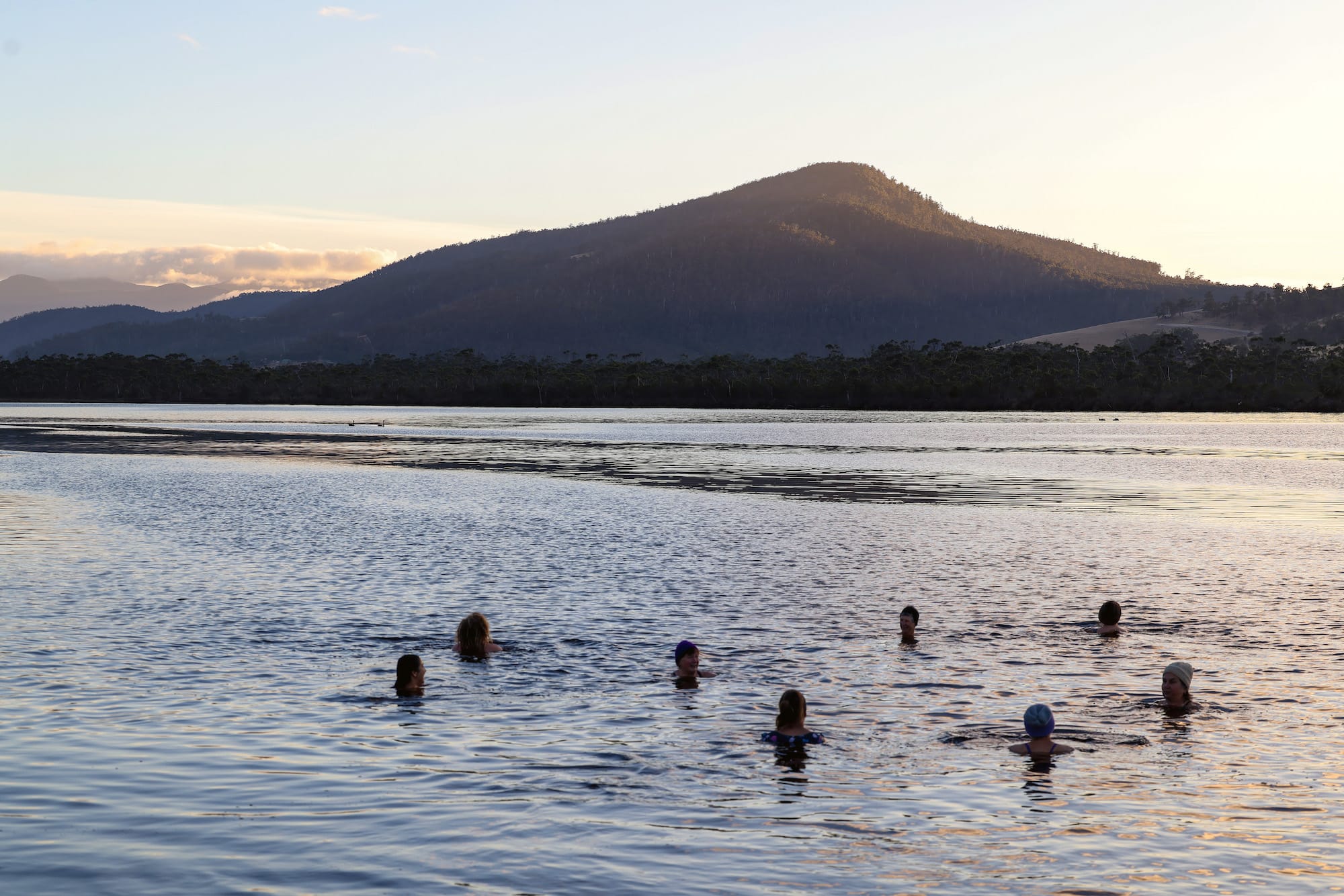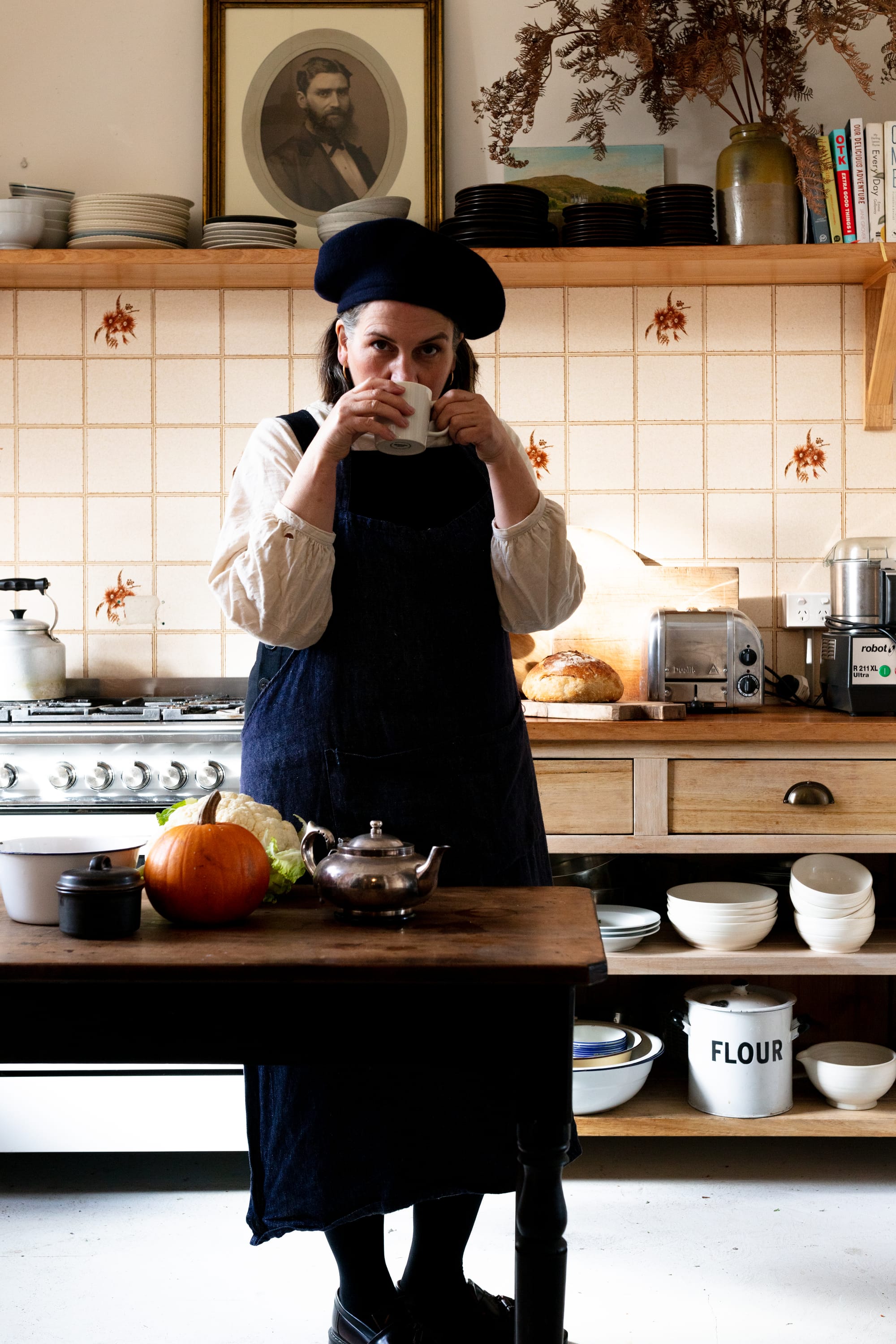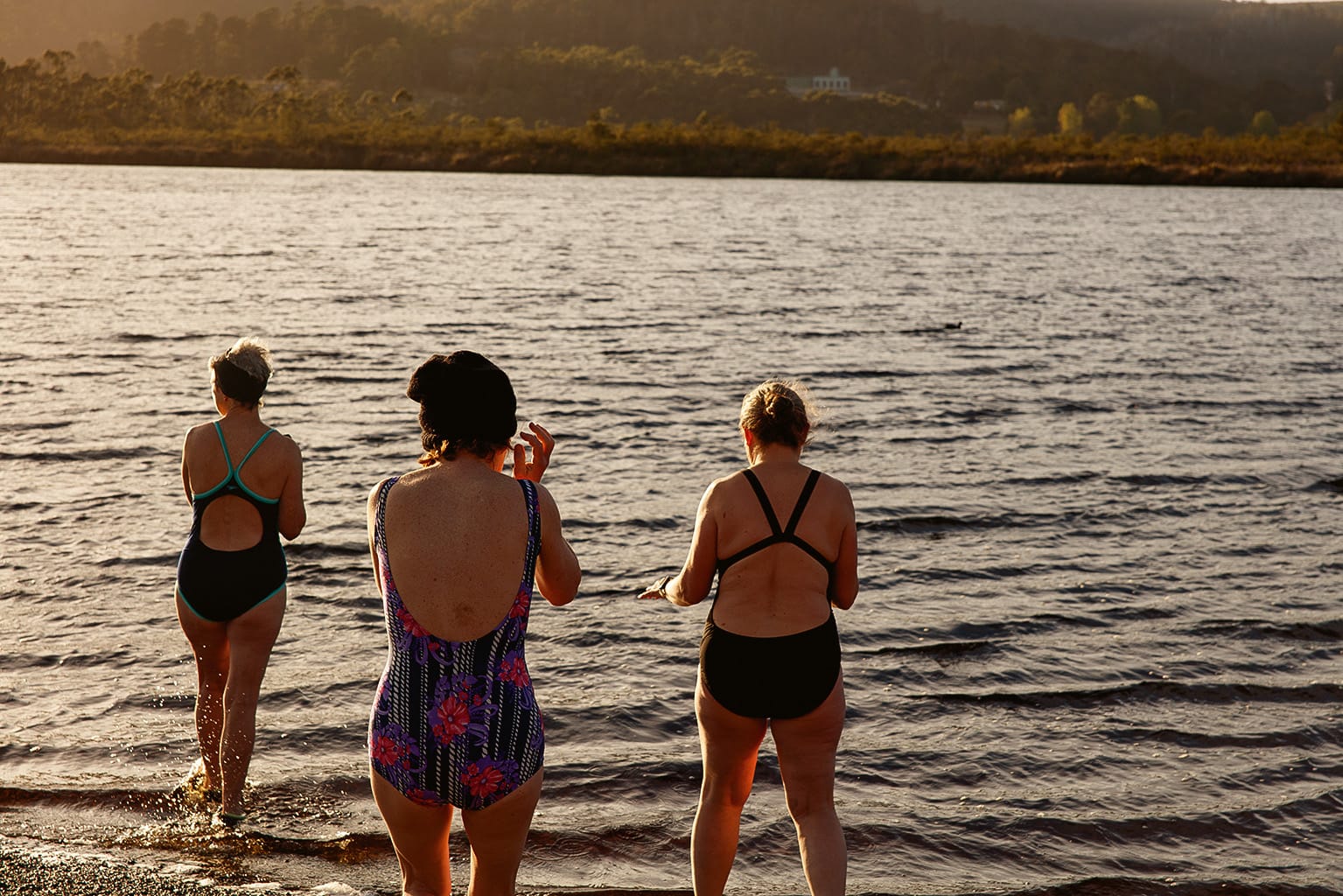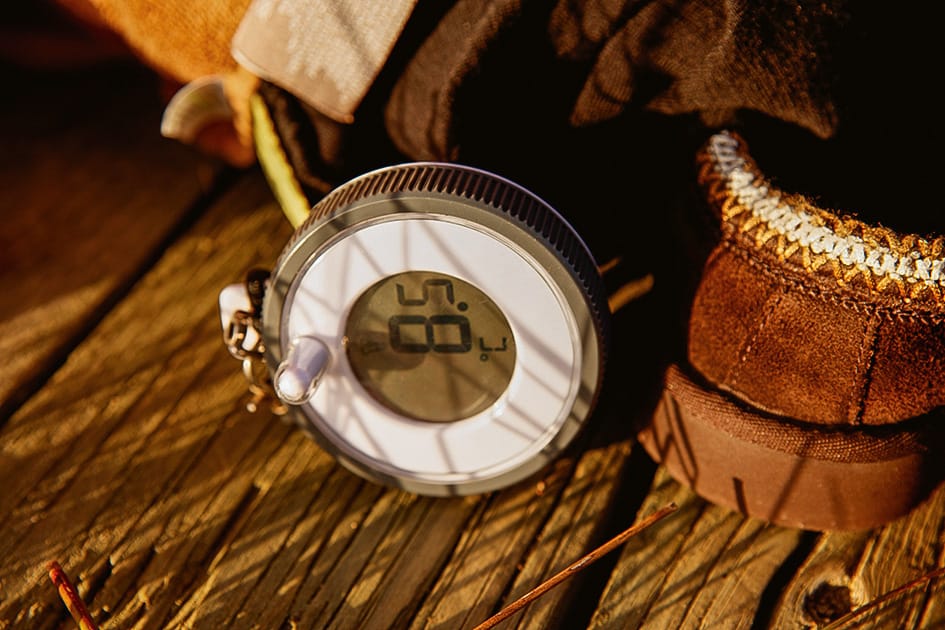

Every morning of the year, a posse of swimmers plunges into the freezing Huon River in southern Tasmania. No wetsuits, no mucking around. Michelle Crawford charts the dopamine rush of cold-water swimming.
Words Michelle Crawford
Photography Michelle Crawford and Jane McCormack
IT'S 7 o’clock on a midwinter’s morning and I really don’t want to get up. I glance out the bedroom window at dark grey skies, pull the blankets over my head and think, “Nah, I’m ditching swimming today.”
Insomnia kept me awake last night, and I whiled away the midnight hours reading. I need more sleep, but then the inner dialogue begins. I don’t know where that stern voice comes from that says “get up”, but I follow orders. Bleary, I dress in swimmers, pile on warm layers, and walk to the foreshore.
The dirt track that runs along the riverbank is quiet in the fog. There’s no-one around – no dog walkers, no birds, just stillness. I walk quickly to the swimming spot at the boat ramp, hoping the fog will lift and I’ll be rewarded with smooth waters reflecting a golden dawn.
I’ve been swimming in the Huon River most mornings for well over a year now with a group that calls itself the Franklin Frosties, based in the southern Tasmanian riverside village of Franklin. At exactly 7.45am every morning of the year, our whooping and hollering echoes across the water as we strip down, walk in and submerge, beanie-clad heads bobbing. Everyone is welcome and we’re a diverse bunch, united by the shared rituals of doing this one crazy thing together every morning.
You’ll spot us with our oversized fleece-lined changing robes, handknitted beanies, diving gloves and water thermometers. But never wetsuits – you’d look like a soft mainlander and it would negate the cold-water benefits of the swim. Resting on the nearby picnic table might be a paper bag of excess homegrown produce someone has brought to share: lemons or rhubarb, or cherries and peaches in summer. There might be some seedlings, and occasionally cake or biscuits. They’re a generous bunch, these Frosties.
Swimming in the river is not really a thing in the Huon Valley. There are virtually no public access points, plus the optics aren’t all that inviting – the scene on arrival is dark and cold, the approach often muddy and tidal – and that alone dissuades most people from taking a dip.
Franklin Frosties started when Lizzie Roarty fell into the river. Formerly from Adelaide, Roarty missed living near the ocean. Despite looking at the river every day, it never occurred to her that anyone would swim in it – until she went on a kayaking adventure on the Huon River about five years ago. “I fell out several times and, to my surprise, the water was clear and refreshing. Then I realised, of course, you can swim in it.”
Roarty set out to find a safe spot to enter the river. “The only place really was the boat ramp in Franklin but I felt so self-conscious going in. I thought I’d feel much better if I had somebody else to do it with.” After posting on a community online page, two people showed up for that first swim in February 2021. That’s how the Frosties began.


The water temperature isn’t announced until everyone is in; sharing the rituals of “doing this one crazy thing together”. Photography by Michelle Crawford.
“Word spread and all of sudden we were getting 15 or 20 people coming for a swim. And we had no idea that we were going to swim through the winter, but we just showed up every day and then it was June, so we thought there’s no point stopping now.”
Frustrated with the lack of online information about swimming groups, Roarty started the Tassie Cold Water Swimming group on Facebook, which is now the go-to guide for residents and travellers seeking a local swimming group. The page has almost 4000 members.
There are only four other swimmers with me today; usually there are about a dozen. I strip off quickly to my swimmers, leaving my woolly beanie on, and walk straight in. Once you’ve tossed off your change robe, you’ve got to get into the water quickly – it’s too cold to hang around in your swimmers. The water is warmer than today’s air temperature of three degrees, so it feels good to submerge my body and escape the breeze. My friend Tom calls it “the peppermint jacket” – the tingling, almost menthol feeling of cold water on skin.
The river is beautiful this morning, and the gentle midwinter sun has risen a little, striking the green hills around us. “Only eight days till solstice!” someone cries, and we all feel a sense of triumph (and relief) that we’re almost at winter’s turning point. The rule of thumb is to swim for one minute per degree of water temperature. No more. The water today is eight degrees, so it’s eight minutes before we reach the hard part: getting out.
The cold breeze is brutal on wet skin, now turned bright red and tingling. I can’t feel my fingers or toes. Shivering, I dress clumsily in clothes that cling to my damp skin and don’t slip on easily, pulled on by numb fingers that don’t work properly.
In midwinter, no-one hangs around the riverfront. The temperature is logged, as is the number of swimmers. On weekends, some Frosties might meet afterwards for coffee at a local cafe, but generally during the week they head home to warm up and get to work. In summer, some stay and chat about small-town issues: what’s on, what’s happening in the garden, the weather, life in general. Occasionally there might be an expedition to a beach for a gathering with other cold-water swimming groups around the state, or a group of Frosties will get together for a hike to an alpine lake for a bracing dip.
No-one is more surprised than me that after living in the Huon Valley for years, I’ve only recently discovered the joys of swimming in the river every day. I’ve been addicted to many things in my life, most of them not very good for me, but never did I think I’d become addicted to the dopamine rush of cold-water swimming.
Something magic happens when you jump in the cool, tannic waters of a river. There’s the initial bracing shock, then within a few moments your body acclimatises and you suddenly find yourself enjoying the swim. The water soothes aches and, as you cut through the silvery surface, you’re surrounded by huge skies filled with dawn light. Cares float away on the tide. It’s one giant exhale. Under the surface, the brackish water is dark and feels soft on the skin, not harsh or stingy like seawater. It sounds crazy, but it feels warm – not in temperature, but in the sense of well-being.
Much has been written about the health benefits of cold-water swimming: improving metabolism, easing aches and pains, boosting circulation and immunity. But for me, cold-water swimming is about more than the health benefits. It’s about, for a moment, being part of a vast, quiet river, along with the black swans, cormorants and grebes. It’s about noticing the river change every day: low tide or high tide coming in or going out; choppy or glassy; benign one day, intimidating the next. The river is epic, unpredictable and bewitching; the only constant is that it’s never the same.
Researching this piece, I asked a lot of Frosties what they loved most about swimming in the cold river. The unanimous response was community and the friendships they had made. As Roarty says: “It doesn’t matter if they have anything in common or not – get a group of people together to do something that’s a little bit hard, a little bit challenging, and they’ll bond and become friends.”
As I walk home, I feel the “peppermint jacket” tingle on my skin. I rarely have a hot shower when I return; it seems a shame to rinse away the river magic with chlorinated tap water. I prefer to let the river linger on my skin for as long as possible. I warm up with a thick woolly jumper, eat a bowl of porridge and sip a hot drink. I don’t regret for a second getting out of a warm bed to take a cold swim.
Exhilarated, I crack on with the day.